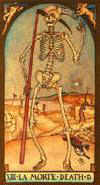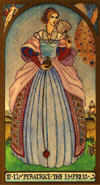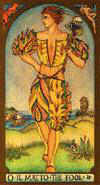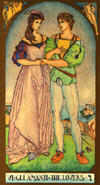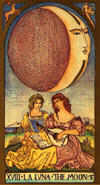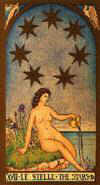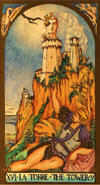Renaissance Tarot Deck Review
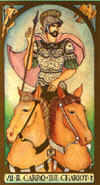
Creators: Brian Williams
Published: 1988
The Renaissance Tarot deck has gorgeous artwork with touches of gold. All twelve deities of Olympus and several other Greek and Roman gods and demigods are pictured in the major arcana. The minor arcana are pips illustrated with small scenes from Greek mythology.
Retailers
See Price at Amazon.comSee Price at Amazon.co.uk
See Price at Amazon.ca
Renaissance Tarot Review by Bonnie Cehovet
This is one of two decks that came to me in a very magickal way - one of the members of a Tarot e-list that I am on had purchased them for herself, only to find that she did not connect with them in any significant manner. I was absolutely thrilled to take both decks off her hands!
The journey that is the Renaissance Tarot spanned a period of ten years - the results show the care, thought and nurturing that was taken every step of the way. Brian Williams had a life long interest in both classical and Renaissance art, which he has translated nicely into the Renaissance Tarot. After spending a year in studies at the University of Padua in Italy. Brian took the illustrations and theory that would become the Renaissance Tarot and used them as the basis for an independent thesis and project at the University of California at Berkeley.
One of the themes that run through this book and deck is the place that Tarot held in European culture. Brian's stated purpose with the accompanying book is to provide a complete guide to the cards, their meanings and their uses. He also goes into the historical significance of each of the cards, which is not something that I have seen done elsewhere. Each card, including the minors, has a bit of myth in it that explains the archetypal qualities of the card, For example, the Ten of Swords is the myth of Paris and Achilles, while the Chariot is the myth of Aphrodite and Ares.
Throughout the accompanying book there are a wealth of black and white illustrations from the Renaissance period. At one point we see the game of Tarot being played (as taken from a mid-fifteenth century fresco in the Sala dei Giochi in the Casa Borromeo in Milan. At another point we see a manuscript illumination of Mars (the God) from the fifteenth century. At yet another point we see an engraving of a Satyr family by Durer from 1505. The list is endless - and fascinating.
With each of the majors we are treated to a wonderful description of the card, quite an involved background into the archetypal myth, and incredible illustrations, as well as divinatory and reversed meanings. With the court cards and the minors we see a description of the card, an abbreviated version of the myth behind it, as well as divinatory and reversed meanings. Each section contains a black and white scan of the card.
At the end of the book Brian presents a section on Tarot spreads, including the Celtic Cross, Tetrasky (also known as the Pythagorean Tetrad) and the Twelve Houses spreads. An interesting aside on the Twelve Houses spread is that it is presented in a square format (referred to as a quadrilateral design), rather than the usual circular format.
The cards themselves are 2 3/4" by 5", on glossy card stock. The backs have a 1/4" white border, with a bisque colored center containing intricate work using triple circles resembling Celtic Knots, upon which reside the medieval symbols for the elements in the four corners, with four corresponding animals floating within them. A male and female figure recline in the center, with their hands held.The almost blandness of the backs acts as a kind of foil for the wonderfully rich colors of the card faces. Again we see the use of a 1/4" white border, followed by a 1/4" gold inner border. The top two corners of each of the cards contain figures (some animal, some human, some symbols) that are there for ornamental purposes only. The title for each card is across the bottom, in both Italian and English.
The overall coloring is a well done pastel, with the figures dressed, for the most part, in Renaissance fashion. The pips make basic use of the suit symbol, with animal and human figures added to them that are not integral to the understanding of the cards. Each suit has its own color: yellow for Swords, pink for Cups, green for Pentacles and blue for Staves.
There are two
small changes in the titling of the Major Arcana: the
Wheel of Fortune becomes Chance and Judgment becomes the
Angel. Each time I return to this deck I find something
new to intrigue me. The accompanying book has lessons
of its own to give. I highly recommend this deck to
all students at all levels of study.
Renaissance Tarot Review by Delia LaForte
I ordered this deck with great anticipation, and perhaps that is why I felt such disappointment with it. The Major Arcana cards are visually appealing, that is, the artwork is beautiful, but I found many of the cards hard to read. The Renaissance fashions made all the figures look alike, and the emblems distinguishing one from the other were just not meaningful enough to me as images. I found I had to keep looking at the name of the card, and relating it to other decks, rather than letting the images speak directly to me. There were only a few images that came through clearly - such as Death, and Fortuna (Wheel of Fortuna). Others had an overlay of meaning that seemed to obscure the card, rather than illuminate. The homo-erotic image for the Sun card seemed to obscure the meaning of this card, while the women playing stringed instruments in a garden seemed way too tame for the Moon.
The Minor Arcana posed another problem. The cards are basically number cards, except for the court cards, again, largely indistinguishable because of costume. The attempt to connect each suit with a story from Greek or Roman mythology is a stretch, and makes the cards just about impossible to read. Two of the suits are made exclusively male, two are more balanced (the stories chosen are Psyche and Persephone, both stories in which males figure heavily.) Although essentially pip cards, there are tiny illustrations from the myths, done in a Renaissance style weaving in and out among the emblems of each suit. Lots of muscles, lots of penises. Maybe the meanings are more accessible to men, but for me, they are chestbeating displays of male anatomy, but little else.
The set came with a book, with chapters on the history of the Tarot, which seemed interesting. However, to call this a breakthrough deck is hardly accurate. The meanings are deeply imbedded in the European Christian tradition, with a patriarchal interpretation of classical mythology.
Renaissance Tarot Review by Christiana Gaudet
How did I miss Brian Williamís Renaissance Tarot when it first came out in 1987?
It really doesnít matter, because itís back!
Thatís right. US Games has republished this amazing deck, along with the full-size guide book, also by Brian Williams. Brian Williams combined his love for classical and renaissance art and his love for tarot in this project that took more than ten years to complete. Williams is known for a number of interesting tarot projects, including Ship of Fools Tarot and PoMo Tarot. His death in 2003 robbed the tarot world of one of its greatest minds.
Renaissance Tarot is a deck like no other. At first glance it looks like an historical tarot deck, similar to a Marseilles deck. The art is of renaissance style, and quite detailed with interesting and symbolic nuances. The deck comes with a little white book, also by Williams.
If you want to work with this deck I would strongly advise you to buy the big yellow book entitled ĒA Renaissance TarotĒ. This tarot is a complex work above and beyond a standard tarot deck. The large-size format 197-page book gives a great deal of information about each card, as well as the art, history, mythology and philosophy of the renaissance on which this deck is based.
The deck is structured fairly traditionally, The Wheel of fortune is called Chance and Judgment is called The Angel. Strength is card 11 and Justice is 8. The intricate card backs are not reversible, though reversed meanings are given in the little white book.
The deck includes a presentation card and a title card. The presentation card is beautifully illustrated.
The Pip cards have unobtrusive keywords written on ribbons in the corners. The top right hand side is in English. The keywords differ from the Crowley pip keywords, and are very different from standard Waite keywords.
The Minor Arcana suits are Coins, Cups, Staves and Swords. Although the focus of each pip card is the icons, there are some small illustrations on the cards that will help with memory and interpretation.
The associations for the suits go way beyond simple elemental associations. Williams discusses the symbolism of each icon as a way of summing up the flavor of each suit. The book also includes some heady tarot spreads and a wealth of illustrations. It is easy to believe that ten years was spent researching and creating this deck.
The art is really stunning, especially for a Marseilles-like deck. The colors are muted. The images are drawn with very fine lines that allow for a lot of detail.
Donít expect to make an easy leap from a Waite deck to Renaissance Tarot. Crowley and Marseilles readers may have an easier time embracing this deck. Tarot beginners who are willing to work with the book will find an intensely rich divinatory tool. Tarotists of all levels of experience will enjoy opening up a new exciting tarot world for themselves with Renaissance Tarot.
There are numerous tarot decks available that work on a system that is somewhat different than the old faithful traditions we know and love. What separates Renaissance Tarot is its scholarly nature. This isnít a system that someone made up or channeled from some unseen spiritual entity.
Renaissance Tarot is based on history, mythology, philosophy and art that was contemporary to tarotís actual birth. There is something about that fact that makes Renaissance Tarot special and important.
It took Brian Williams ten years of his all-too-short life to create this tarot. Donít worry if it takes you a while to master it. The Renaissance Tarot is a worthy legacy, and an important contribution to the body of tarot art, knowledge and understanding. Three cheers for US Gamesí decision to allow this deck its own renaissance!
Complete Details of Renaissance Tarot
Creators: Brian WilliamsPublisher: US Games 1988
Deck Type: Tarot Deck
Cards: 78
Major Arcana: 22
Minor Arcana: 56
Deck Tradition: Rider-Waite-Smith
Minor Arcana Style: Pips with Small Scenes
Suits: Swords, Staves, Cups, Coins
Court Cards: Page, Knight, Queen, King
The Fool is 0
Strength is 11
Justice is 8
Card Size: 2.76 x 4.96 in. = 7.00cm x 12.60cm
Card Language: Italian, English
Card Back: Non-reversible
Back Design: Line art, circles with figures
Companion Material: Little white booklet in English.
Rating: 16/20 or
Similar Decks to Renaissance Tarot
Theme: Ancient Greek, Gay, Medieval & RenaissanceCategory: Decks With Changed Suit/Element Associations, Tarot Decks from the 1980s
Creator: Light and Shadow Tarot, Minchiate Tarot, PoMo Tarot, Ship of Fools Tarot by Brian Williams
< Previous Deck · Back to Top · Next Deck >
Home > Tarot Reviews > Renaissance Tarot Review

